Wall of Service
Column
20
Row
1

“Sapper” Melvin E ( Mel ) Clark
MEDALS:
39/45 star
Italy Star
France Germany Star
Defense of Britain Medal
CVSM (Can Volunteer Service Medal) Victory Medal
...................................................................................
September 1939 war declared
1941 - Joined the Canadian Army and trained in Petawawa, Ontario
August 1941 - Left Halifax for Scotland on the Cameronia / 18 years old
August 19th, 1941- Arrived in Scotland
August-September - sent to south of England by train... stayed in Aldershot / Box Hill / Dorkin / Farnboro area / Embery
On scheme along the coast ( Brighton ) with the 1st Battalion Engineers
1941-1942 - Soldiers and equipment were moved all over England to trick Germany into thinking more troops were stationed there than really were.
Scotland to Sicily June 1943
The need for battle experience and the growing public demand for action led to a decision to include the 1st Canadian Infantry Division and the 1st Canadian Army Tank Brigade in the assault on Sicily.
This was the prelude to the invasion of mainland Europe.
The invasion was carried out by the Seventh U.S. Army under Lieut.-General George S. Patton, and the Eighth British Army under General Sir Bernard L. Montgomery
Under command of Major-General G.G. Simonds, the Canadian troops sailed from Great Britain in late June 1943
En route, 58 Canadians were drowned when three ships of the assault convoy were sunk by enemy submarines, 500 vehicles and a number of guns were lost. On the 8th and 9th they ran into storms called "Sorocos" that almost delayed the invasion.
Late on the night of July 9, the Canadians joined the invasion armada of nearly 3,000 Allied ships and landing craft.
The Invasion of Sicily
July 10th, 1943 - Sapper Mel Clark lands at Pachino, Sicily 4:40am
The go order came / Mel’s group number was called, ( # 26 ) …they loaded onto landing craft ( LCIs ) attached to the ship and lowered into the pounding sea ...in the dark ( not like training in Scotland )
The Canadians, forming the left flank of the five British landings that spread over 40 miles of shoreline, Mel went ashore near Pachino close to the southern tip of the island.
The landing crafts ended up on sandbars by mistake, everyone had to jump into neck deep water with their 70 lbs of gear and rifles in order to get ashore. An accurate account of this landing can be found in the Farley Mowat book "And no Birds Sang"...he was landing on another beach close to where Mel was let off
The sun came up shortly after the landing...DUSTY...HOT...dried and curled up his boots
Within 2-3 days Mel’s truck carrying disarmed mines hit a land mine in wet sand but luckily just the detonator went off and the only casualty was a tire.
July 15th, 1943 - Grammichele / hilltop town / German ambush... 25 Canadians died.
From the Pachino beaches, Canadians pushed forward through choking dust, over tortuous mine-filled roads.
At first all went well, but resistance stiffened as the Canadians were engaged increasingly by determined German troops who fought tough delaying actions from the advantage of towering villages and almost impregnable hill positions.
July 18th/19th - Piazza Armenia and Valguarnera fell on successive days, - 40 Canadians died.
As a “Sapper” Mel cleared mines, was an explosives expert, built Bailey bridges, went on commando raids, fought on the front line.
Stories of Bailey bridges being built and erected during the Second World War are legendary. The very first instance of a Bailey being erected under fire was at Leonforte /The “Bailey” provided an excellent solution to the problem of German and Italian armies destroying bridges as they retreated.
Next the Canadians were directed against the hill towns of Leonforte and Assoro.
Assoro Ridge / Mel ( with the Hasty P's ) / took part in a commando raid down ravines and up the back slopes of the mountain to surprise attack the enemy (in the dark with little or no trails). The defensive advantages of the mountainous country led to bitter fighting, but eventually German positions fell to the Canadian assault.
July 28th, 1943 - After five days of hard fighting at heavy cost, Agira was taken. Meanwhile, the Americans were clearing the western part of the island and the British were pressing up the east coast toward Catania.
These operations pushed the Germans into a small area around the base of Mount Etna where Catenanuova and Regalbuto were captured by the Canadians.
The final Canadian task was to break through the main enemy position and capture Adrano. Here again, the Canadians faced not only human enemies, but physical barriers as well.
The rugged, almost trackless country meant that mule trains were required to bring forward mortars, guns, ammunition and other supplies.
Nevertheless, literally fighting from mountain rock to mountain rock, the Canadians advanced steadily against the enemy positions.
With the approaches to Adrano cleared, the way was prepared for the closing of the Sicilian campaign.
August 7th, 1943 - The Canadians, withdrawn into reserve, did not take part in this final phase. Eleven days later, British and American troops entered Messina. Sicily had been conquered in 38 days.
The operation had secured a necessary air base from which to support the liberation of mainland Italy. It also freed the Mediterranean sea lanes and contributed to the downfall of Mussolini, thus allowing a war-wearied Italy to sue for peace.
In taking Sicily the Allies aimed to trap the German and Italian armies and prevent their retreat across the Strait of Messina. Both the U.S. and British wanted the glory of VICTORY...
But delays by Allied commanders allowed the enemy an escape to Italy and a chance to fight again...a blunder that cost many lives during the Italian campaign
The Canadians had acquitted themselves well in their first campaign. They had fought through 150 miles of mountainous country - farther than any other formation in the Eighth Army - and during their final two weeks had borne a large share of the fighting on the Army front. Canadian casualties totaled 562 killed, 664 wounded and 84 prisoners of war.
Invasion of the Italian mainland
September 3rd, 1943 - Mel headed to Reggio on Ducks... a "Harbour Hopper" style landing craft.
.......................................................................................
CBC News Online
September 3rd, 1943 - The Allied landing force left the Sicilian ports of Catania, Augusta and Syracuse for landing beaches between Taormina and Messina. The British Eighth Army consisted of the First Canadian Division, the Fifth British Division and the First Canadian Tank Brigade
The Canadians' objective was Reggio, Calabria, where they met little resistance because the Germans were pulling back to a series of fortified defensive positions to block the Allied advance.
Later that day, the government that succeeded Mussolini surrendered and Italy turned to do what it could to support the Allies. A week later, the Canadians were in Catanzaro, 120 kilometers from the beaches.
But another landing, this time at Salerno by the U.S. Fifth Army (actually a joint force with two British and two American divisions under the command of lieutenant general Mark Clark) ran into trouble as it met stiff German resistance.
The Canadians were ordered to make a hurried assault on Potenza, an important crossroads and railway junction east of Salerno to relieve pressure on the Fifth Army.
Then, as the Fifth Army moved north toward Naples, the Canadians turned east through the rugged Appenine Mountains and then north along the east coast toward Foggia. On October 1st and 2nd, 1943, the Canadians were involved in their first major battle against the Germans in Italy at a corkscrew highway through the town of Motta.
The Royal Canadian Regiment and the Calgary Tank Regiment attacked Motta, while the Hastings and Prince Edward Regiment went after the Monte Mianoa, on a ridge dominating the countryside.
Two weeks later, the Canadians captured the town of Campobasso, then ran into in to heavy resistance from the Germans at Vinchiaturo, but routed them out in a one-day battle.
As the first snows of winter began to fall, the Canadians reached the German defensive line north of the Sangro River. And after fierce fighting alongside troops from New Zealand and India, the Canadians forced the Germans back to a second defensive line in the Moro Valley. To the west, meanwhile, the U.S. Fifth Army was held up again on the road to Rome near Cassino.
The Canadians attacked the Germans along a road to the town of San Leonardo, but not on the main highway as the enemy was expecting. The Canadian advance took the lightly garrisoned town by surprise, just as the Fifth Army achieved a breakout from the Salerno beachhead.
The Germans were able to counterattack and the Moro Valley saw some of the bitterest and fiercest fighting of the Second World War including artillery exchanges and hand to hand combat.
After a battle lasting ten days, the Canadian soldiers had pushed the Germans back to the ancient town of Ortona overlooking the Adriatic. Artillery from both sides pounded Ortona and the Germans also used mortars fired from nearby hills to try and slow the Canadian advance. Much of Ortona was reduced to rubble, making it difficult for the Canadians to use tanks. The Germans barricaded themselves in houses and mined streets. The fighting was house-to-house- literally.
Ortona / a victory for all Canadian troops - and all Canadians
Ordinary men, volunteering to leave civilian life behind because they were needed, had forged regimental extended families and small cohesive units that fought with skill and determination.
Captain Paul Triquet of the Royal 22nd Regiment was awarded the Victoria Cross for his actions in Casa Berardi, a small town overlooking Ortona.
The battle for the town of Ortona, a small port on Italy's Adriatic coast is one of the best known battles fought by the Canadians in the Second World War: a battle of great innovation and adaptation in which the rifle companies had begun the operation at little better than half-strength. All the hardware of the infantrymen was brought to bear against this entrenched foe.
The Canadians fought house by house for Ortona, which was given the nickname "Little Stalingrad" by radio journalist Matthew Halton.
Lieutenant-Colonel J.C. Jefferson described the situation confronting his men as a "vicious circle." Once the infantry had seized a group of houses, sappers (engineers) moved up to clear mines and booby traps.
Both infantry and tanks were needed to cover the sappers while they performed this and other dangerous work. Attempts to hurry things up by outflanking the enemy were especially difficult in the dense narrow streets, and the fighting resumed its old pattern-for one house at a time.
Mel served with the 1st Div / Hasty P's / 1st Field Co. Engineers but was on loan now to the Loyal Edmonton Regiment just for the Ortona battle ...they needed explosive experts
He had to carry 10-15 pounds of explosives called Aminol along with the detonators…fought house to house using a technique Canadian soldiers used called "Mouse Holing"...blasting through walls and lobbing grenades to clear the staircases and upper floors…all the while confronted with booby traps. Here the Canadians wrote the book on street-fighting.
Further attempts to force an enemy withdrawal were interrupted by a ferocious storm that was to stand as a metaphor for the end of one year of bloodshed and the beginning of a new year of savagery.
The enemy, offering a forecast of what was to come, spent the last hours of 1943 in making a savage counter-attack that burst through the two forward companies of the Carleton and York Regt.
December 24th, 1943 - During the night, 1st Field Company lifted their scissors bridge and built a 40 foot single Bailey bridge in it's place. This was a difficult task, as there was intermittent shelling and Mortar fire throughout the night. In Addition, 1st Field Company supported tanks of 12 C.T.R. with mine sweeping parties.
..........................................................................................
January 1944 - Sent to the Gustav Line ( Winter line )
In the spring of 1944, the Germans still held the line of defense north of Ortona, as well as the mighty bastion of Monte Cassino which blocked the Liri corridor to the Italian capital. Determined to maintain their hold on Rome, the Germans constructed two formidable lines of fortifications, the Gustav Line, and 14.5 kilometers behind it, the Adolf Hitler Line.
The monastery, high on a peak overlooking the town of Cassino, was destroyed by 1400 tons of bombs. The bombing was based on the fear that the abbey was being used as a lookout post for the Axis defenders (this position evolved over time to admit that Axis military was not garrisoned there)
February to May, 1944 - Monte Cassino battle: ( Mel was there in April)
The Gustav defenses were assaulted four times by Allied troops. These operations resulted in casualties of over 54,000 Allied and 20,000 German soldiers
May 18th, 1944 - Battle ended
May 31st, 1944 - The Canadians occupied Frosinone and their campaign in this area came to an end as they went into reserve.
.........................................................................................
Mel wounded in action / Spilotto / October 1944
Hit near Spilotto by shell fragments from a mortar attack while working on a bridge...sent by truck to the 5th general field hospital in Avalino Italy.
Covered in blood from his own wounds and wounds dripping from a soldier in the stretcher above him made for quite a messy scene...Mel met the driver of that rescue vehicle later in life (1990s)...the guy could not believe dad survived.
November / December 1944 - Mel leaves Naples on the hospital ship The Lady Nelson bound for Birmingham England to recover more over Christmas.
Holland
January 1945 - Mel was “back on strength” and sent to Holland / Belgium / stationed near Visalstrat / old stone barracks. Met Roddy Reid (from his home town Shubenacadie)… Roddy was with the North Nova Scotia Highlanders in Leopoldville...Roddy’s sister Dorothy would end up being Mrs. Melvin Clark in 1949 …Other areas Mel served in Holland were Ostend and Gronigan
Nijmegen Bridge/Holand … The Germans wanted it destroyed, they would float explosives down the river to that end. ...one of Mel,s jobs was to shoot and blow up anything getting through the Engineer’s safety nets put in place across the river upstream.
The Liberation of Holland was completed on May 5th, 1945 by the First Canadian Army. It had been a long and difficult campaign.
January 1946 - Cunard's most famous passenger ship, the express liner “Mauretania” brought Dad back from England to Halifax / Pier 21
....................................................................................
General Material:
Reference Video / Fighting in Holland:
www.veoh.com/videos/v6278612QpPPq6DY?c=History-WorldWarII
Exerpt from a 1945 news report:
1st Canadian Army, is called upon to pursue the enemy through the flooded Low Country, clearing the Scheldt estuary - a task equal to that of D-Day - and opening the port of Antwerp to allow for the huge influx of supplies necessary to press on against the German forces, now fighting with mounting desperation and ferocity.
After enduring the worst winter in local memory, and spending yet another Christmas far from home, in the spring of 1945 the Canadians are thrust into the crucial Battle of the Rhineland, which will eventually allow Allied forces to plunge into the heart of the Reich.
When victory comes, it is with no sense of triumph over a vanquished foe, but with the profoundest relief that this most terrible conflict in history is finally over.



